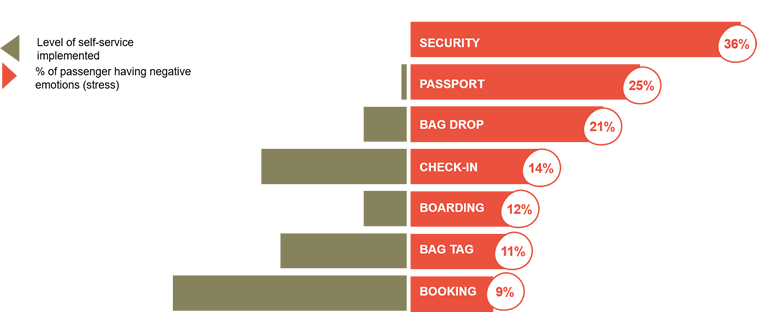The words “frictionless” and “seamless” are often used to describe what the border crossing procedure should feel like for passengers and those moving goods across borders. In my view, a frictionless experience at the border should enable a passenger to arrive in a country and walk non-stop from the aircraft gate to the baggage hall and out to the kerb.
And I know it doesn’t need to end at the kerb: if we get it right, the frictionless experience can continue through to booking a rental car, hotel check-in and even access to special events and tourism services in the destination country.
Creating frictionless and high capacity biometric borders is critical because there simply won’t be enough physical space available to process twice as many passengers by 2037 (IATA forecast).
Technology advancements make it possible
I should also emphasize that biometric technology, particularly facial recognition, has come a long way, with match rates giving a far higher degree of certainty that someone is who they say they are. Add to that the ability to use video feeds to biometrically verify passenger identities ‘on the move’ and you quickly see how automated controls at the border can become an integral part of tomorrow’s seamless traveller journey.
One case in point is a recent US Exit Project in which the US Customs & Border Protection (CBP) agency reported a match rate of >99% from biometrics captured in an uncontrolled environment, all of which were processed, verified and approved in less than a second. I am amazed that what was almost impossible to imagine just a few years ago – i.e. automatically processing an entire family or group of passengers at the same time – is now possible, thanks to a number of important advances in biometric facial recognition technology.
Immense mobile opportunity
There’s an immense opportunity to leverage whatever devices passengers have in their hands, such as a smart phone or tablet. If those devices could be used to capture and verify data and empower passengers to send it directly to governments, we could see a step change in the number of passengers pre-cleared for arrival in the destination country.
We know this is a viable way forward as passengers have expressed their willingness to send personal information directly to governments, provided this delivers a benefit such as a fast-track arrivals experience. This has been a key finding of our own Passenger IT Insights surveys.
More automation, less stress

Governments must trust data from mobile devices
Governments will find it hard to trust data sent by a mobile device from a passenger they’ve never seen before. So we must help them trust this data. There’s an important international initiative underway, thanks to ICAO, in the form of the Digital Travel Credential (DTC). In the medium to long term, the DTC will enable governments to have far greater trust in biometric and biographic data they receive directly from passengers as it will immediately establish that the data is genuine, isn’t forged and hasn’t been tampered with in any way.
New, intuitive passenger-centric approaches
Because the airline industry is interconnected at so many levels, we must think through potential unintended consequences. One example comes from feedback on e-Gates and low adoption rates of Registered Traveller Programs. Many passengers have pointed out that by speeding up this step in the process (i.e. crossing the border), they now have to wait even longer for their bags to arrive in the baggage claim area.
If passengers onboard a flight are pre-cleared, the airline and ground handler can use that information to determine where those passengers’ bags are loaded in the hold. That way, it can be taken off first. The same would apply for passengers who may have rented a car or ordered a taxi as part of their booking. Cars can be brought to the kerb and taxis sent to the taxi stand to synchronize with the flow of arriving passengers.
New, intuitive approaches therefore need to take on a ‘passenger-centric’ view that unlocks the pathway to seamless, secure and frictionless journeys.
What advice might governments want to consider?
It’s important to review current paper-based processes and identify which ones can be digitized and what regulations or policies may need to change. For example, if governments receive high quality, verified electronic data from the passenger and/or the airline, what’s the value of stamping a passport? Or having passengers fill out a landing card and customs declaration form? A digital version enables additional checks, statistics and deeper insights. By improving and accelerating controls at the border, we need to see what else we can do to drive even more improvements.
Governments will want to understand their responsibilities with regard to the storage of personally identifiable information and how that aligns with national data protection requirements and international benchmarks, such as the EU’s General Data Protection Regulation (GDPR).
They will want to work with partners who have not only done this type of work before, but who also understand the environments in which they need to be used; and how to integrate it with the systems and processes already in place.
Finally, I’d like to stress that trials and proof-of-concept projects are a really good way to test new processes and ideas before rolling them out on a larger scale. Importantly, the industry must collaborate with governments to co-create a more integrated ecosystem, rather than just building standalone niche solutions. Integration across countries, ports, carriers and identity services will deliver exponentially greater benefits.
Let’s bring stakeholders together
One of the main ways we can help governments is to bring stakeholders together. This demands an understanding of government, airline and airport systems. Perhaps more importantly than the ability to interconnect systems, it requires an understanding of the business processes in place.
I’d also like to underline the importance of developing a Global Passenger Data & Identity Management Trust Framework to interconnect stakeholders. This will enable them to make better use of high quality, verified data – confident it has been accurately captured and verified – and exchanged in a way that everyone can use it and trust it. With a Global Trust Framework, we wouldn’t need to develop initiatives and programs for specific (and limited) cohorts of passengers.
It’s this type of thinking that helps governments have greater confidence in their plans to build secure, frictionless borders and accelerate the crossing of ever-increasing numbers of passengers.
For more
For governments undertaking new border management initiatives there’s a need to design the right approach with speed and confidence. Learn how SITA’s Government Professional Services team can help.
Read more about SITA’s integrated solution for Border Management that provides governments with a complete set of capabilities to modernize border security through information, intelligence, optimized interactions with travelers and comprehensive insights. It enhances every aspect of border operations.




 Share
Share



0 Comments